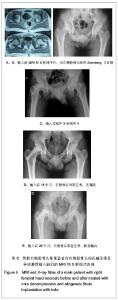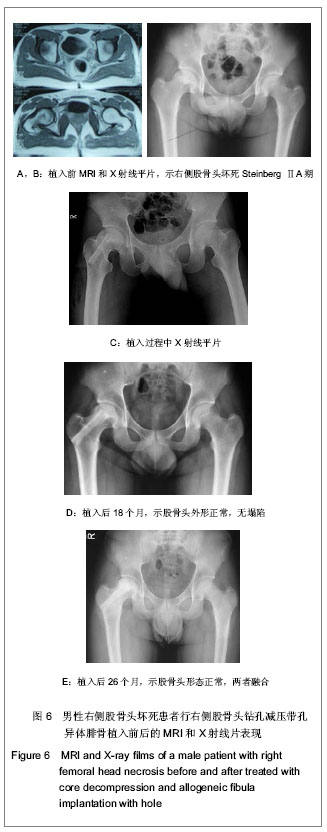| [1] Lieberman JR, Berry DJ, Mont MA, et al. Osteonecrosis of the hip: management in the 21st century. Instr Course Lect. 2003; 52:337-355.[2] Zhang GL, Zhang M. Progress of vascularized bone grafting for the treatment of avascular osteonecrosis of the femoral head. Zhongguo Gu Shang. 2008;21(7):556-558.[3] Guo XZ,Dou BX,Zhou YX,et al.Zhongguo Xiufu Chongjian Waike Zazhi.2005;19(9):697-699.郭晓忠,窦宝信,周乙雄,等.股骨头髓心减压加异体腓骨移植术治疗股骨头坏死[J].中国修复重建外科杂志,2005,19(9):697-699.[4] Xu WH,Yang SH,Li BX,et,al. Zhongguo Xiufu Chongjian Waike Zazhi. 2009;23(5):527-529.许伟华,杨述华,李宝兴,等.同种异体皮质骨支撑骨笼联合自体骨移植治疗股骨头坏死[J].中国修复重建外科杂志,2009,23(5): 527-529.[5] Zhou EC ,Zhu CY, Tang P. Shandong Yiyao. 2011;51(11): 92-93.周恩昌,朱传英,唐萍.经股骨颈开槽死骨刮除、按压力骨小梁方向植骨治疗股骨头坏死35例疗效观察[J].山东医药,2011,51(11): 92-93.[6] Liu ZH,Guo WS,Cheng LM. Zhongguo Jiaoxing Wake Zazhi. 2011;19(11):904-907.刘朝晖,郭万首,程立明.坦棒治疗早期非创伤性股骨头坏死的回归性研究[J].中国矫形外科杂志,2011,19(11):904-907.[7] Zhang HJ,Gao ST,Hu YC,et al. Zhonghua Guke Zazhi. 2010; 30(1):48-52.张宏军,高书图,胡永成,等.髓芯减压联合自体骨髓干细胞移植治疗股骨头坏死的早期临床观察[J].中华骨科杂志, 2010,30(1):48-52.[8] Zhang HS, Li ZR.Zhonghua Guke Zazhi. 2007;27(2):146-148.张鹤山,李子荣.股骨头坏死诊断与治疗的专家建议[J].中华骨科杂志,2007,27(2):146-148.[9] Steinberg ME, Larcom PG, Strafford B, et al. Core decompression with bone grafting for osteonecrosis of the femoral head. Clin Orthop Relat Res. 2001;(386):71-78. [10] Mao BY. Beijing:The Publishing House of People′s Health. 2001.764-765.毛宾尧.人工髋关节外科学[M].北京:人民卫生出版社.2001: 764-765.[11] Zhang CQ,Ceng BF,Xu ZY,et al. Zhongguo Xiufu Chongjian Waike Zazhi. 2004;18(5):367.张长青,曾炳芳,徐铮宇,等. 吻合血管腓骨游离移植在股骨头缺血性坏死中的应用[J].中国修复重建外科杂志,2004,18(5):367.[12] Malizos KN, Karantanas AH, Varitimidis SE, et al. Osteonecrosis of the femoral head: etiology, imaging and treatment. Eur J Radiol. 2007;63(1):16-28.[13] Wang HM, Yang XF,Zhang YB.Linchuang Guke Zazhi. 2007; 10(6):528-530.王红梅,杨晓风,张轶斌.自体骨髓干细胞治疗激素性股骨头坏死[J].临床骨科杂志,2007,10(6):528-530.[14] Guo WS, Li ZR. Zhonghua Guke Zazhi. 2010;30(1):19-24.郭万首,李子荣.股骨头坏死的保存自身关节治疗[J].中华骨科杂志,2010,30(1):19-24.[15] Aaritimidis SE ,Dimitroulias AP, Karachalios TS,etal. Outcome after tamtalum rod implantion for treatment of femoral head osteonecrosis; 26 hips followed for an average of 3 years.Acta Orthop.2009;80(1):20-25.[16] Mei RC,Yang SH. Zhongguo Weichuang Waike Zazhi. 2007; 7(2):168-170.梅荣成,杨述华. 同种异体骨支撑架微创治疗股骨头坏死的临床研究[J].中国微创外科杂志 2007,7(2):168-170.[17] Aldridge JM 3rd ,Urbanniak JR.Avascular necrosis of the femoral head :role of vascularized bone grafts. Orthop Clin North Am. 2007;38(1):13-22.[18] Yang J,Kang DP,Shen B,et al.Zhonghua Guke Zazhi.2010; 30(1):58-61.杨静,康德鹏,沈彬,等.小孔径多通道髓芯钻孔减压治疗早中期股骨头坏死[J].中华骨科杂志,2010,30(1):58-61.[19] Schneider W,Breitenseher M,Engel A,et al.The value of core decompression in treatment of femoral head necrosis. Orthopade. 2000;29(5):420-429.[20] Nöth U, Reichert J, Reppenhagen S, et al. Cell based therapy for the treatment of femoral head necrosis. Orthopade. 2007; 36(5):466-471.[21] He W,Li Y,Zhang QW,et al.Zhongguo Xiufu Chongjian Waike Zaizhi. 2009;23(5):527-529.何伟,李勇,张庆文,等.自体或同种异体腓骨联合打压植骨治疗股骨头坏死的初步研究[J].中国修复重建外科杂志,2009,23(5): 527-529.[22] Xu YF,Lin L.Heilongjiang Yixue.2008;32(1):10-13.许宇飞,林林.髓芯钻孔减压异体骨移植治疗股骨头缺血性坏死的CT影像研究[J].黑龙江医学,2008,32(1):10-13.[23] Wang HF,Wang JC,Linchuang Guke Zazhi. 2010;13(5): 563-565.王华锋,王静成.骨小梁金属(多孔坦)棒植入治疗早期股骨头坏死的研究进展[J].临床骨科杂志,2010,13(5):563-565.[24] Mont MA,Hungerford DS.Non-traumatic avascular necrosis of the femoral head. J Bone Joint Surg(Am).1995;77(3): 459-474.[25] Yang SH,Yang C,Li BX,et al.Zhonghua Guke Zazhi. 2006; 26(5): 313-316.杨述华,杨操,李宝兴,等.强化力学结构治疗股骨头坏死的临床研究[J].中华骨科杂志,2006,26(5):313-316.[26] Wang KZ,Tong ZQ,Wang CS,et al.Zhonghua Xianwei Waike Zazhi.2000;23(4):254-256.王坤正,同志勤,王春生,等.吻合血管游离腓骨移植治疗股骨头坏死[J].中华显微外科杂志,2000,23(4):254-256.[27] Lin ZJ,Su PJ,Wu Zq,et al.Zhongguo Gushang.2009; 22(8): 628-630.林志炯,苏培基,伍中庆,等.股骨头髓芯减压加异体腓骨移植术治疗股骨头缺血性坏死[J].中国骨伤,2009,22(8):628-630.[28] Sun YQ,Wang SZ,Zhang GY,et al. Zhongguo Gu yu Guanjie Sunshang Zazhi. 2009;24(12):1148-1150.孙永强,王上增,张国永,等.股骨头坏死增强力学结构和防止塌陷的临床和试验研究进展[J].中国骨与关节损伤杂志,2009, 24 (12):1148-1150. |

